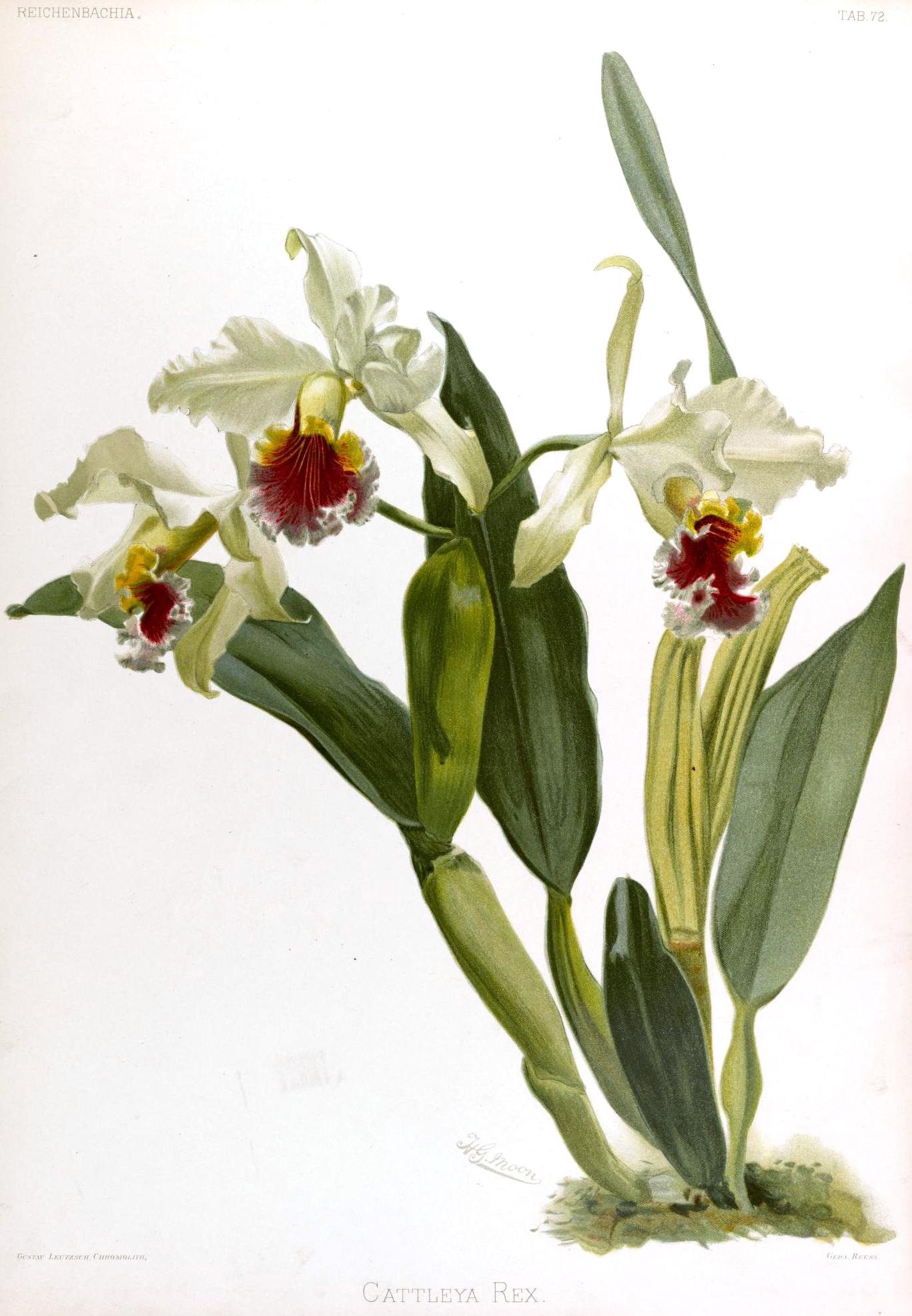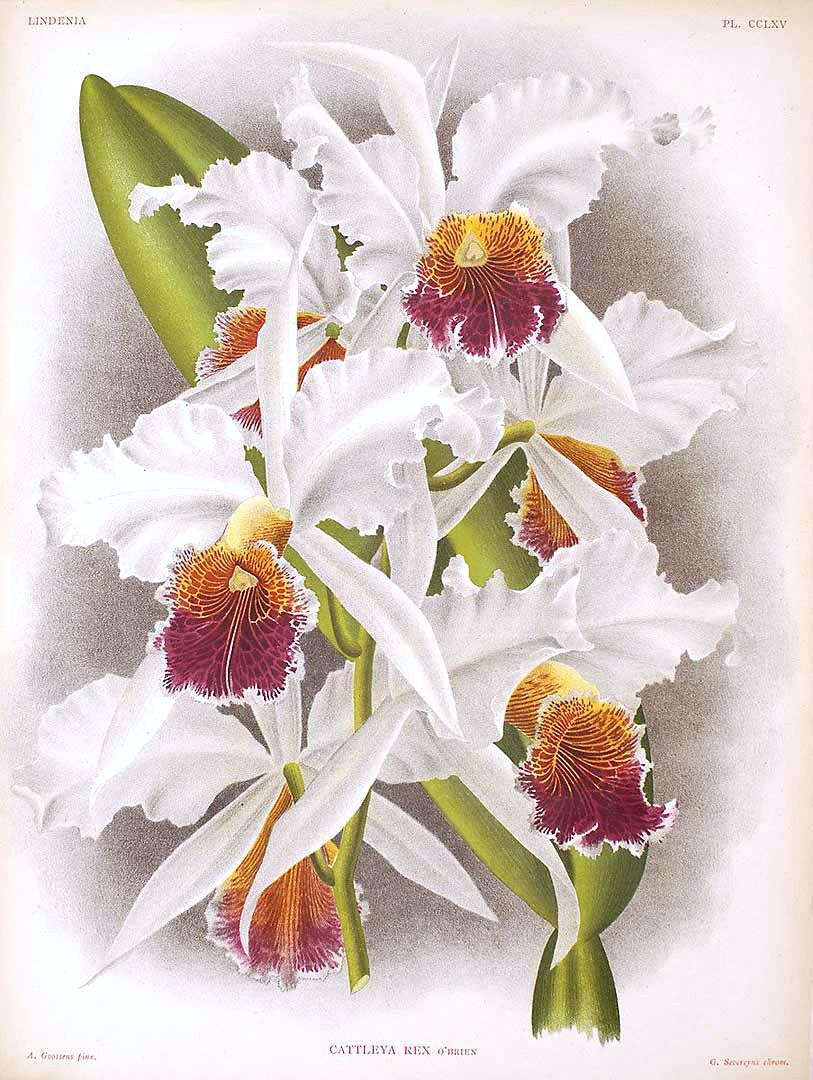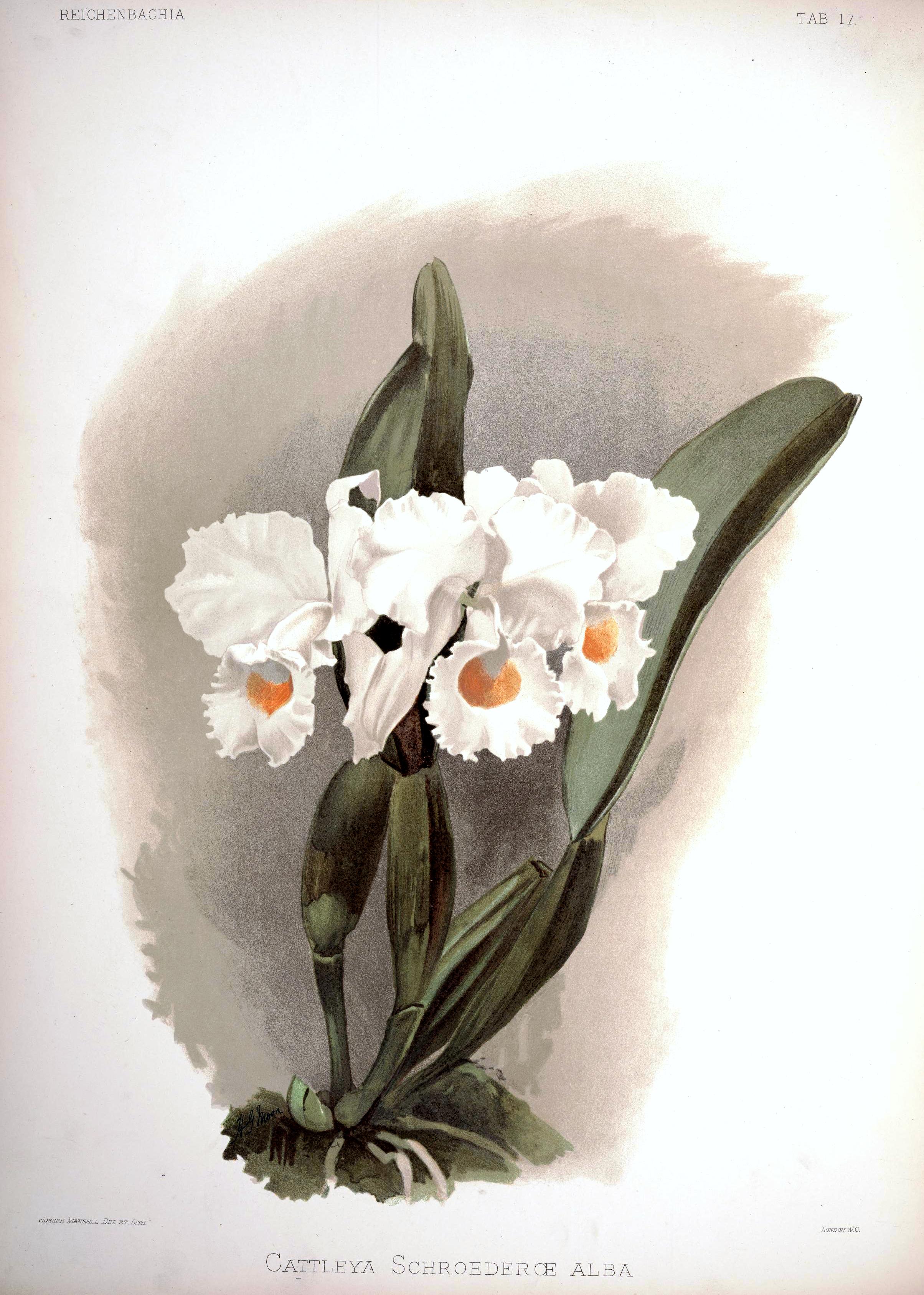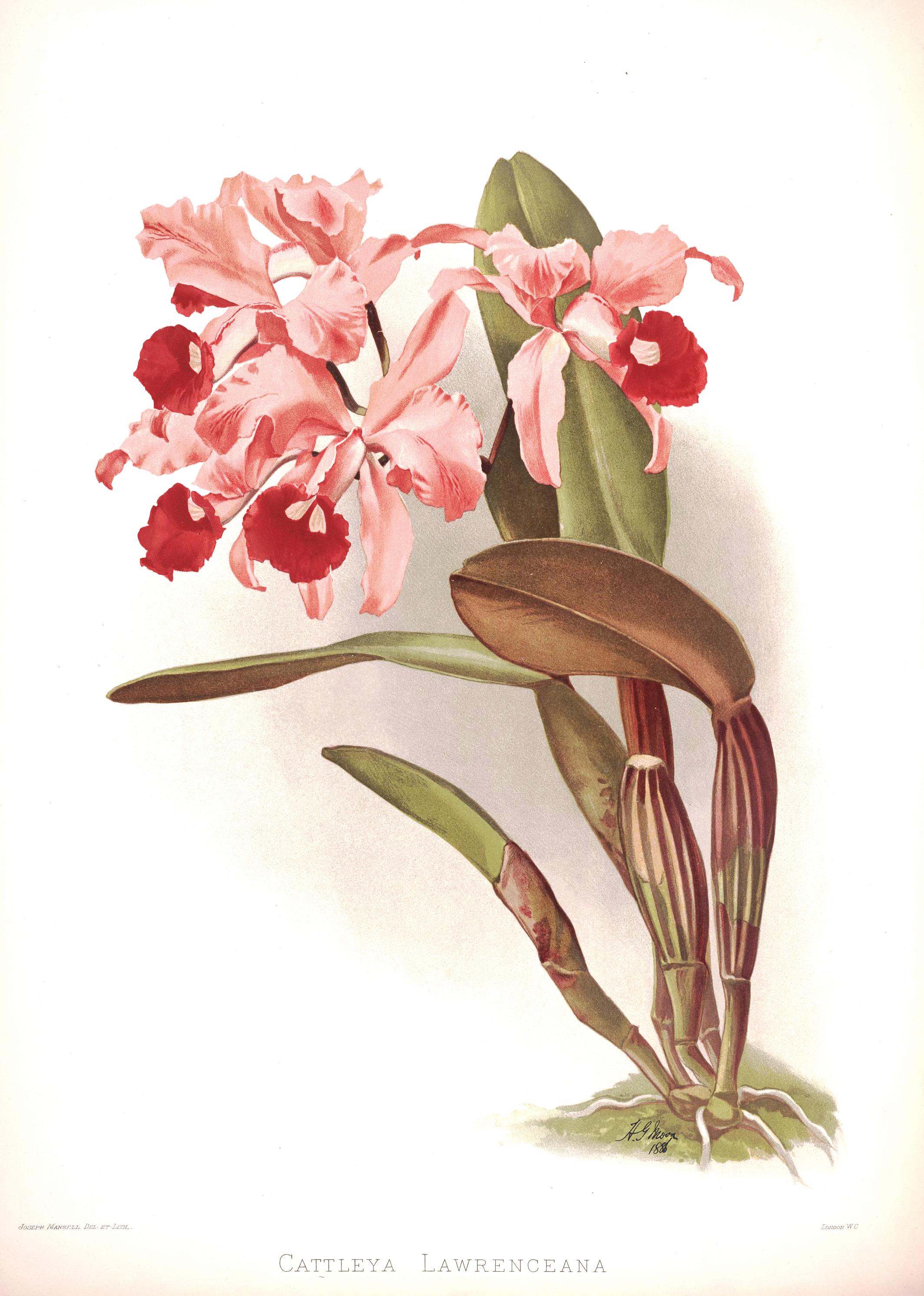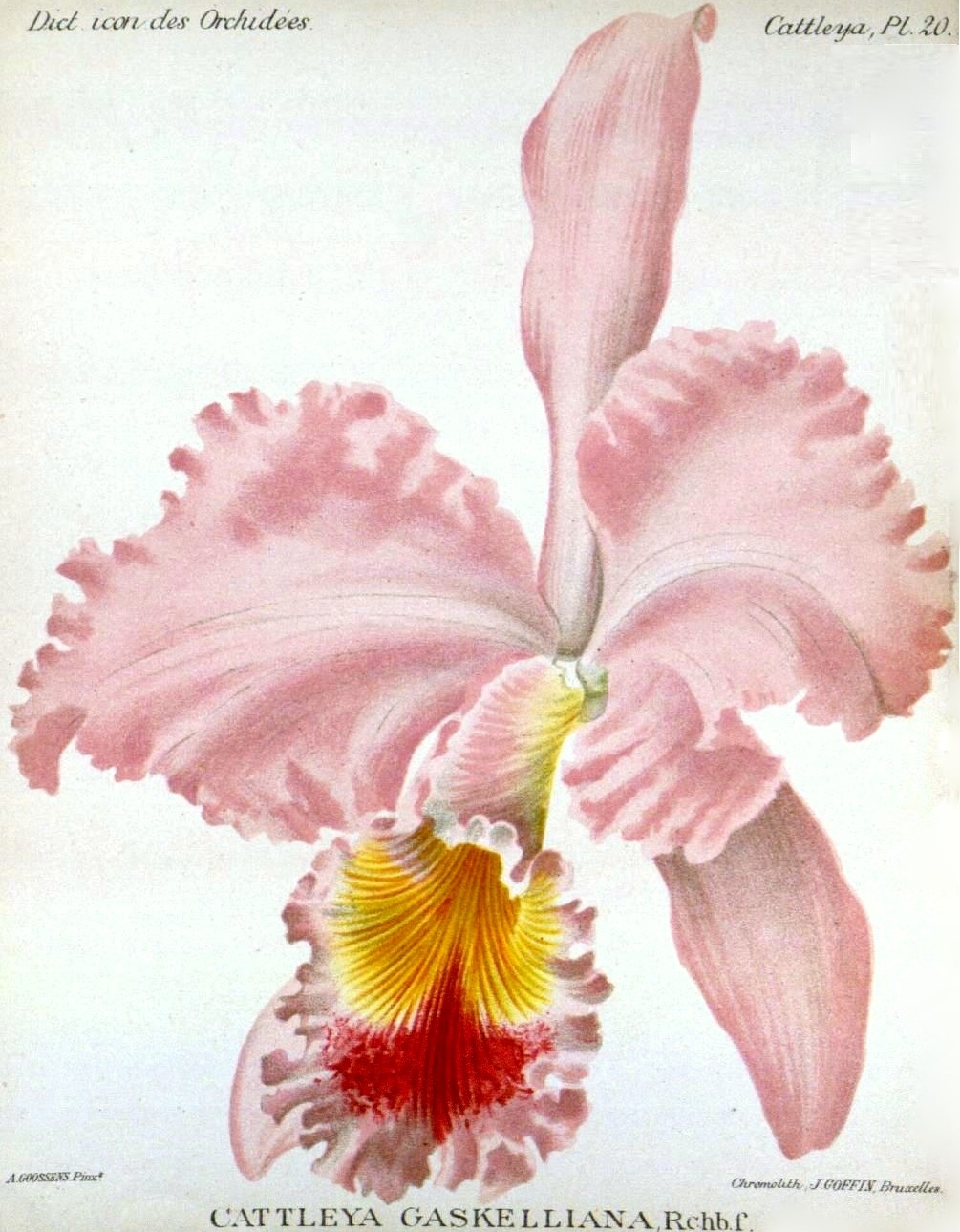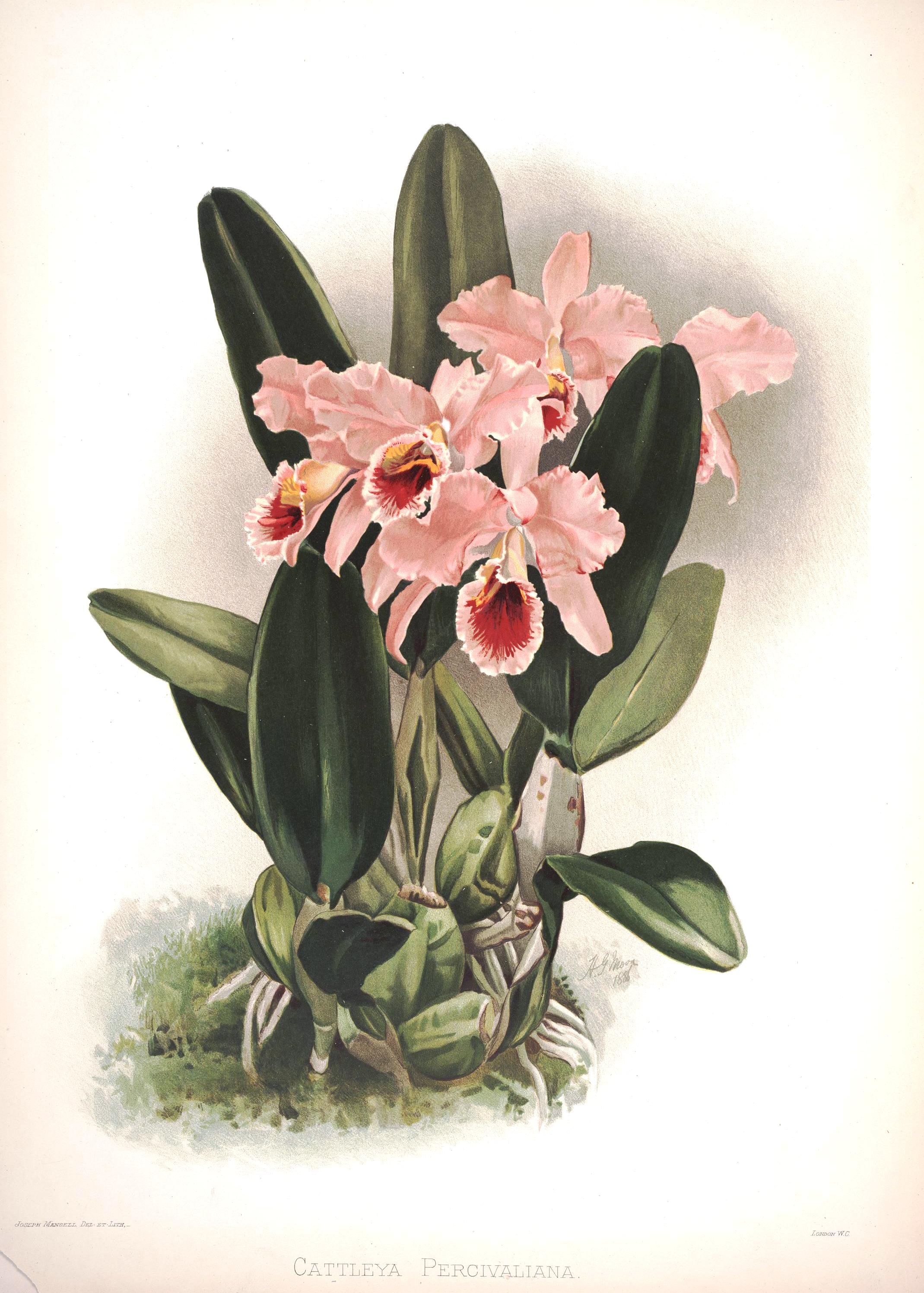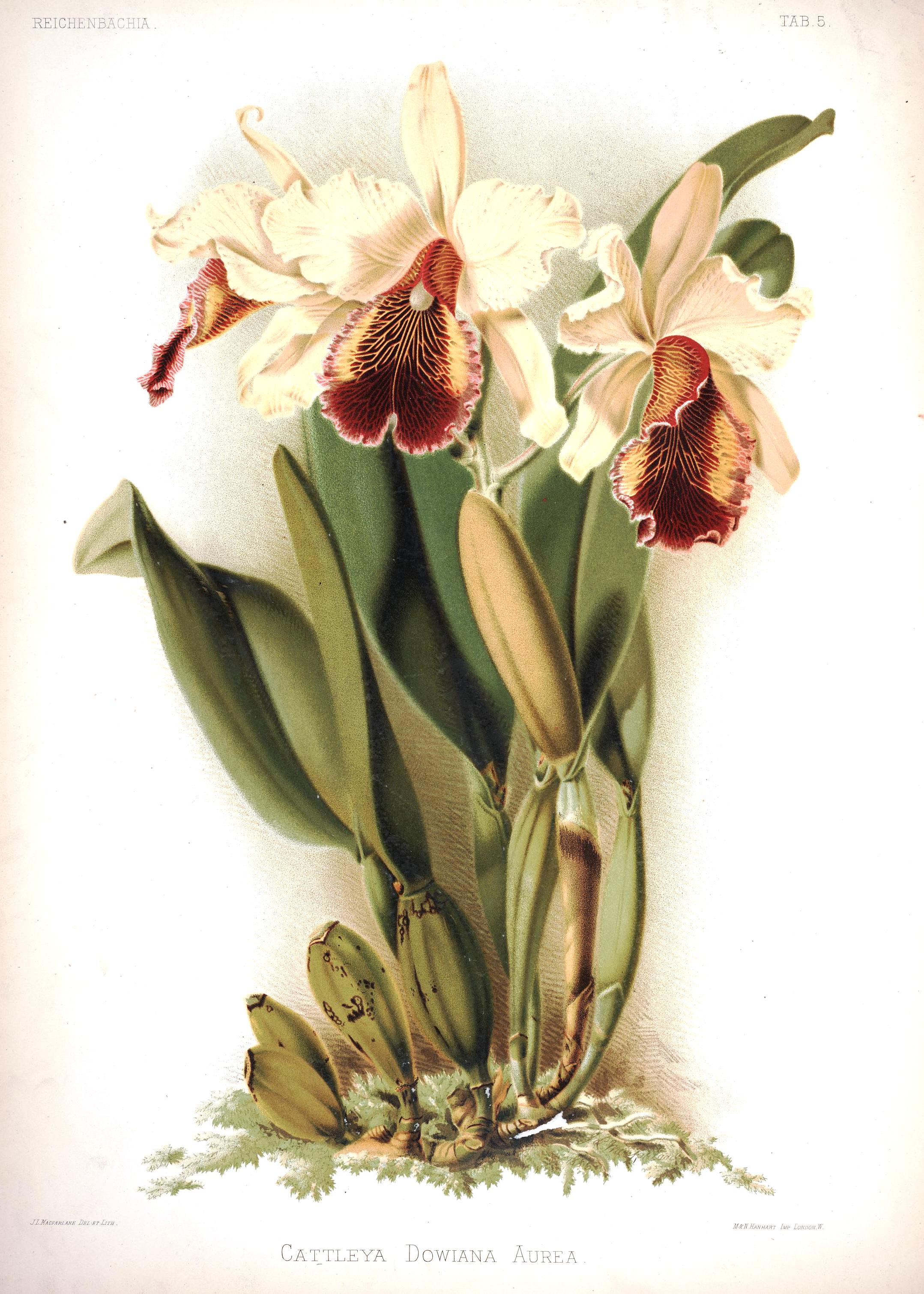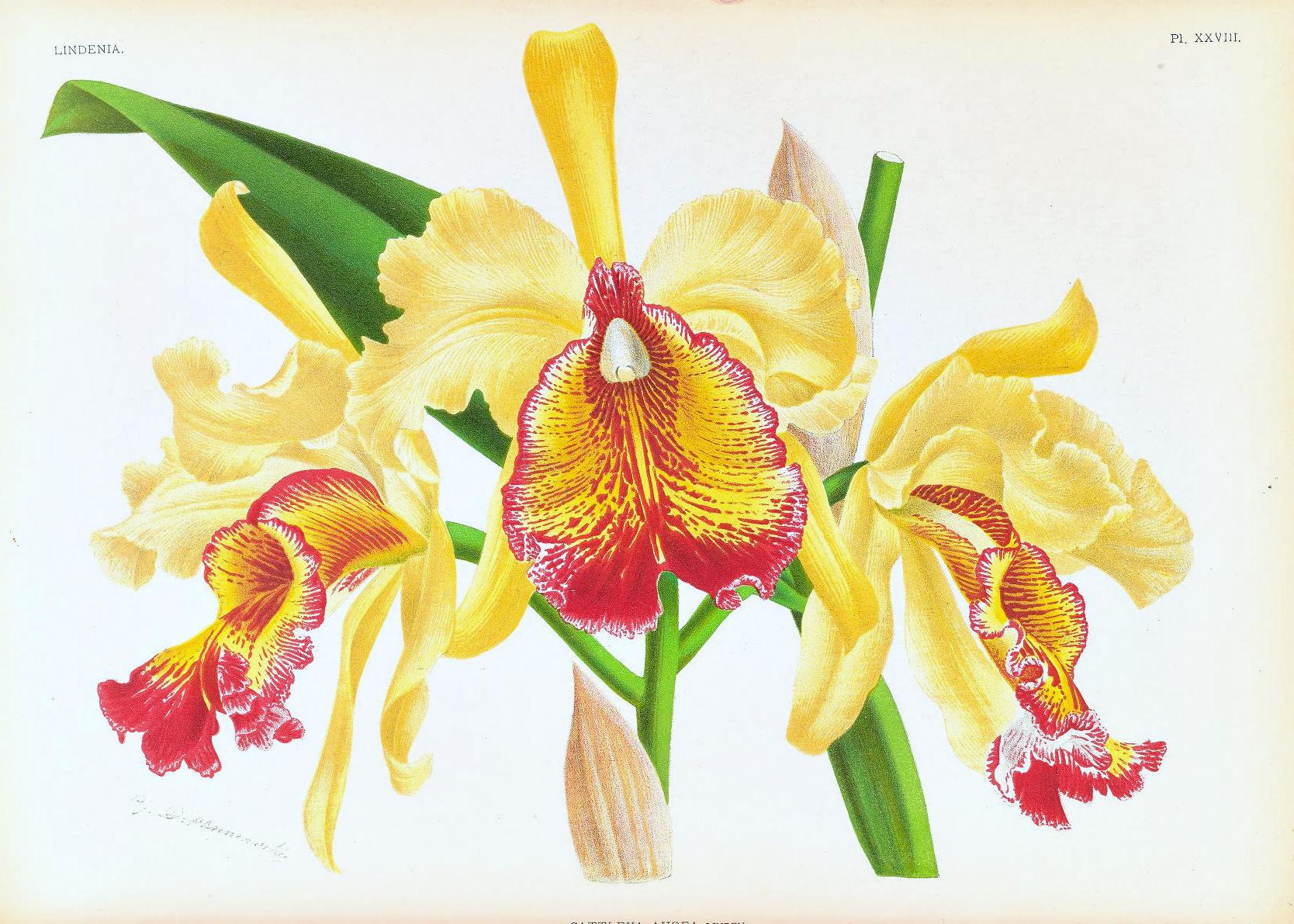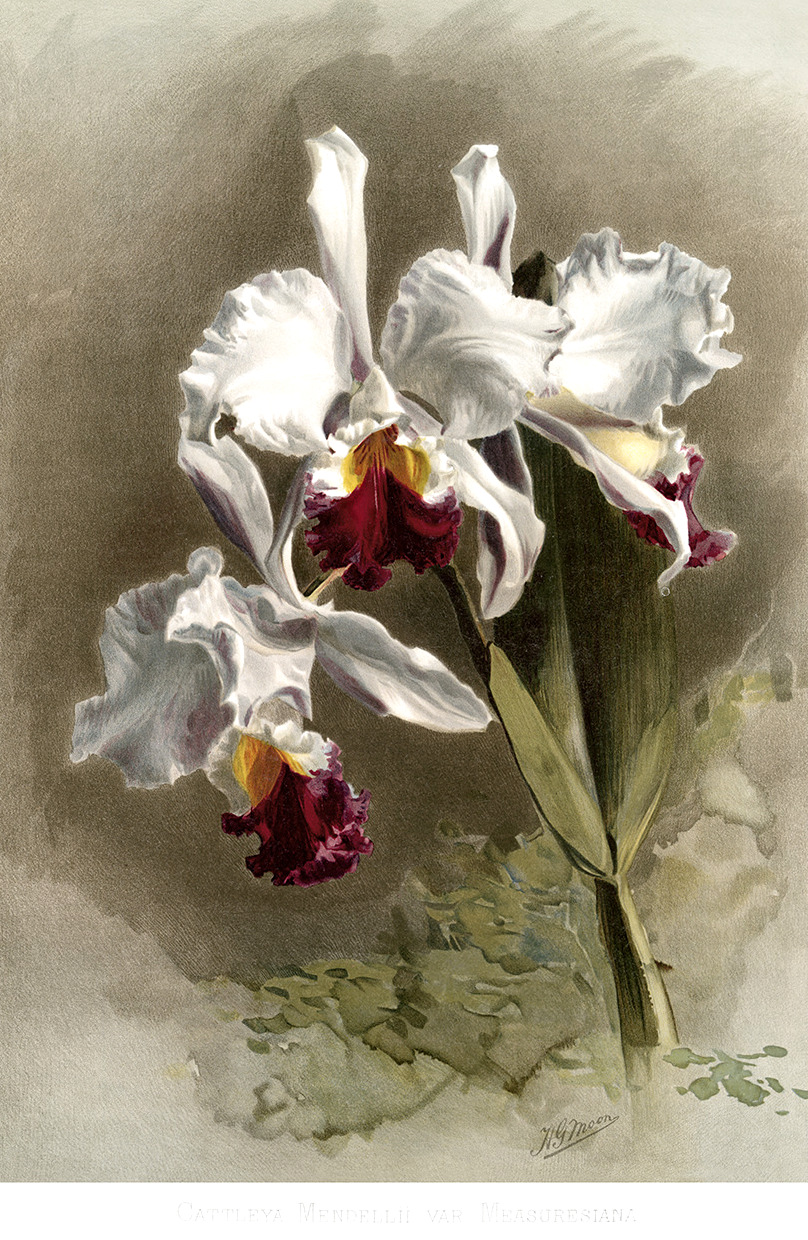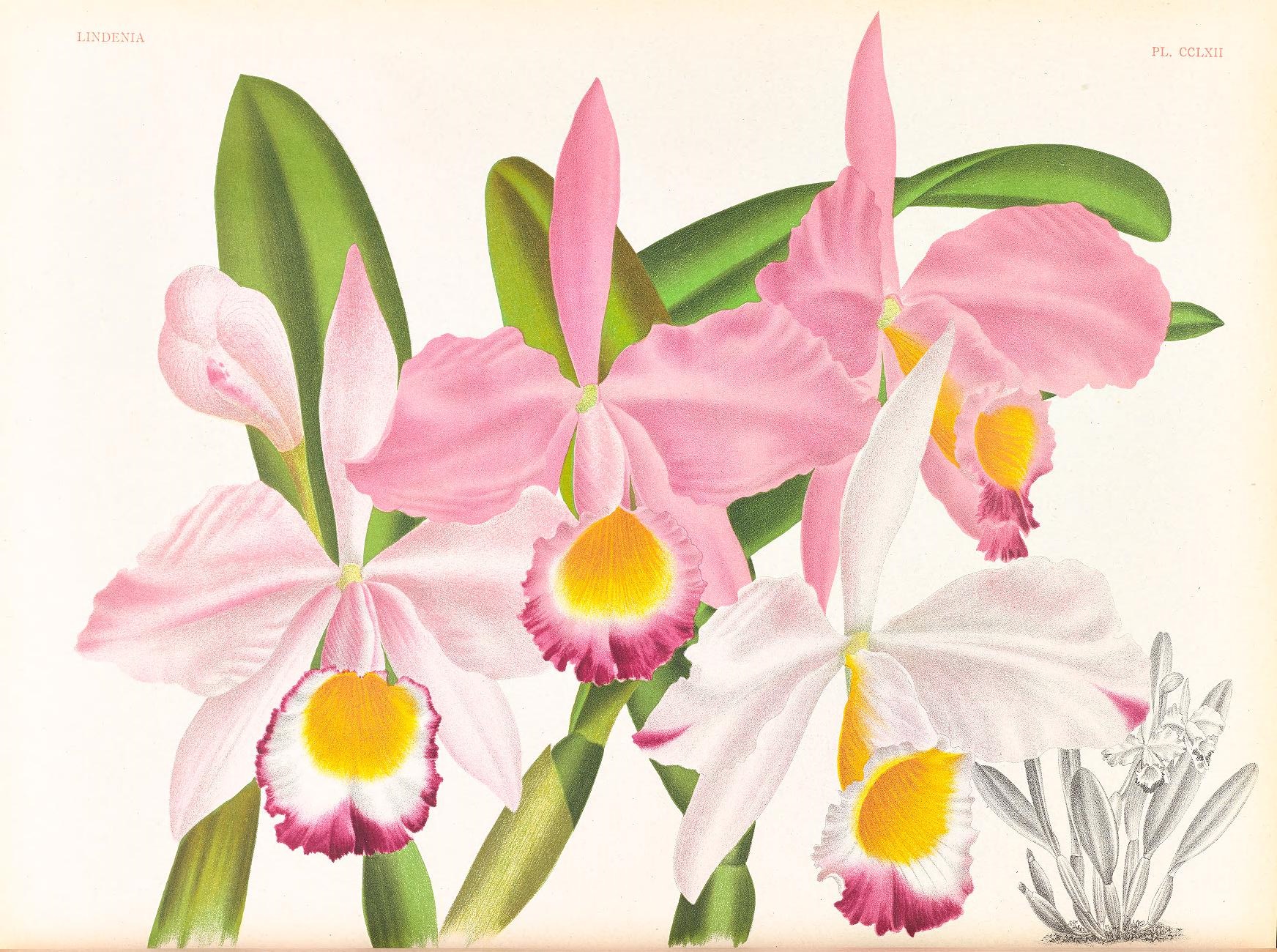The genus Cattleya was described by John Lindley in 1824 and named after William Cattley, a renowned English merchant and horticulturist of the time, with a predilection for orchids. To date, the genus has 114 species distributed throughout tropical America. Here are 18 large-flowered unifoliate Cattleyas, their origin, and blooming season in US.
Cattleya jenmanii Rolfe
Bulletin of miscellaneous information Kew 1906: 85 (1906)
Cattleya jenmanii was described by Robert Allen Rolfe in 1906. Its name is a tribute to the English botanist George Samuel Jenman, who discovered the species in the headwaters of the Mazaruni River, near Georgetown, Guyana. Paradoxically, this beautiful species was completely hidden from science and growers until 1969, when it was rediscovered in Venezuela thanks to the construction of the Troncal 10 highway, which crosses the Gran Sabana to the border with Brazil.
It is present in Guyana, Venezuela and northern Brazil. In Venezuela, it is located south of Bolívar state, in the Gran Sabana, between parallels 4° and 5° north latitude and meridians 61° and 64° west longitude.

It grows between 800 and 1,200 meters above sea level in dense and very humid forests, generally epiphytic, although it can be found on rocks on the steep walls of the tepuis, in full sunlight. Currently it is intensively collected by the indigenous people of the area, who sell it to tourists who come by the hundreds to enjoy the wonderful landscape.
Cattleya jenmanii is unifoliate, of moderate size. The pseudobulbs are compressed, attenuated towards their base, with four or five internodes. They can reach about 20 cm in length and their leaves are very leathery, elliptical, up to 25 cm in length. The spathe, green when flowering, is almost always simple, although a second, very small internal spathe may occur.
It blooms at two times of the year, between February and April, and then in September and October. Immediately after the pseudobulb matures it produces clusters of up to 7 large flowers, which can reach 17 cm in diameter.
It has a sweet perfume. The typical coloration is pale lilac to dark purple. The lip, with gently wavy edges, has a purple spot on the front disk that can extend to the throat, and its characteristic white “eyes”, one on each side. The purple spot can be solid or a group of streaks.
Currently there are clones of great quality, coming from genetic improvement, especially in the type and semi-alba varieties, superior in size, color and shape to what was traditionally known until a few years ago. In the varieties alba and coerulea it is little that has been able to improve the species; wild clones are few and of modest quality.
Among the most outstanding cultivars we have:
- type: Rubra, Katherine, Nazareno, Nitsuga
- semialba: Armando Mantellini
- alba: Sandra
- coerulea: Elena
Some concolor and albescens variety plants are also known.
Cattleya jenmanii can easily be confused with Cattleya labiata, since the appearance of its flowers can be very similar in some cases, and even its aroma can be quite the same (although that of tends to be sweeter and more penetrating). To clear up doubts, it is necessary to have the plant and verify that the leaves of Cattleya jenmanii have a slight sharp bend towards the underside, along the entire length of the edge. Cattleya mossiae and Cattleya labiata can also present this characteristic, but never Cattleya labiata.
Cattleya jenmanii is basically a dwarf-pseudobulb member of the large-flowered group of cattleyas, and this compact habit, along with its strong, wonderful fragrance and free-flowering nature, are the most distinguishing features of the species.
There are considered to be two biotypes that come from somewhat separated areas. One type has light to medium-lavender flowers with relatively good shape and large size. The other type produces smaller, more poorly shaped flowers, but with much richer color.
Notable varieties:
- C. jenmanii f. alba ‘Fuchs Snow’ FCC/AOS – received a rare First Class Certificate from the American Orchid Society
Notable Primaries:
- C. x gransabanensis – a natural hybrid between C. jenmanii and C. lawrenceana. , was found.
Cattleya rex O’Brien
The Gardeners’ Chronicle ser. 3 vol. 8: 684 (1890)
Notable varieties:
Despite the similarity of most flowers, of course, C. rex still has the normal color types for which all the large-flowered Cattleya species are famous. There is a very rare alba form, a semialba, and a pale pastel delicata. There are C. rex, with solid crimson lips, and a few clones with splashes of yellow in the sepals and petals. Not all C. rex are 7 inches across, as were the flowers O’Brien and Linden saw. Harry Blossfeld seems to have imported a number that were in the 6- to 7-inch range, but most C. rex are closer to 4 inches across. Cattleya rex is one of the most floriferous of the large-flowered Cattleya species, and will normally produce five or six flowers on a spike, and there are records of as many as nine and 10 flowers.
- C. rex ‘Splash Mariza’ – Angela Mirro’s grand watercolor, is so outspoken in its praise of C. rex that it spent the entire spring this year on display at the Smithsonian Institution in Washington, DC, shown on book page 198
- C. rex ‘Purple Flare’ – has unusual purple tinge along the center vein of the petals, shown on book page 134
- C. rex ‘Grande’ – unusually large and bold variety, shown on book page 135
Notable Primaries:
- C. Triumphans (C. dowiana x C. rex) – had yellow-petaled flowers, so in reality, there are two yellow large-flowered Cattleya species
Cattleya schroederae (Rchb.f.) Sander
The Gardeners’ Chronicle ser. 3. vol. 1: 512 (1887)
Notable varieties:
Its bright, delicious fragrance was distinctive and different from the subtle fragrance of C. trianaei. Its petals and lip were more frilly or crisped, and it was a more vigorous grower. It also produced more flowers on a stem than C. trianaei. C. schroederae has always been considered a feminine flower. Its lovely pale lavender color is often described as ‘overlaid with pink pearl’ has a tantalizingly sweet fragrance. C. schroederae lacked the wide range of color found in C. trianaei, and yet it competed with C. trianaei for the late-February to early-March flower sales. C. schroederae produced three to five flowers on a spike, unlike C. trianaei, which had only two or three. C. schroederae can have seven flowers on a spike if exceptionally well-grown, and can produce a magnificent specimen. One such plant was even pictured in June 1903’s The Orchid Review and the March 1953 American Orchid Society Bulletin. Cattleya schroederae’s excellent shape garnered it nine FCCs from the Royal Horticultural Society in the first 20 years following its discovery. Two of the finest and eventually most famous clones of C. schroederae on the mountain slopes above the Casanare River collected by John Lager:
- C. schroederae f. alba ‘Hercules’ AM/RHS (1925), AM/AOS (1932) – was a beautiful, round, alba form with an orange throat, and striated lateral sepals. It was so fine that Lager used its picture to adorn the stationery of his own orchid company, Lager & Hurrell in Summit, New Jersey. The flower was also pictured in the September issue of the first volume of the AOS Bulletin in 1932.
- C. schroederae ‘Summitensis’ / ‘The Baron’ FCC/RHS (1908) – this was a large blush flower with an intense reddish-orange throat and purple lip. ‘Summitensis’ had a fine round shape and was also sold to a private collector. It was was later acquired by Major George L. Holford (Sir George Holford of Westonbirt fame) who exhibited it under the name ‘The Baron’
More of notable clones of C. schroederae:
- C. schroederae ‘Pitt’s Variety’ FCC/RHS (1901) – did have sepals and petals of a medium lilac color, one of the darkest clone of C. schroederae
- C. schroederae ‘Severn’s’ – modern day dark clone of C. schroederae that approaches the dark coloring of ‘Pitt’s Variety’
- C. schroederae ‘The Prince’ AM/RHS (1910) – very dark lavender form of the species with wide-open lip
- C. schroederae ‘Alexandra James’ AM/RHS (1909) – very wide-open lip
- C. schroederae f. alba ‘Madame Louis de Hemptine’ FCC/RHS (1905) – alba form with sepals that curl backward
- C. schroederae f. alba ‘Mrs. F. Sander’ FCC/RHS (1909) – alba form with overall nice compostition
- C. schroederae ‘Fowler’ AM/RHS (1904) – overall pastel coloring with very impressive golden egg yolk-pink lip and striated lateral sepals
- C. schroederae ‘Glebelands’ FCC/RHS (1912) – overall white form with sepals that curl backwards with rich pink and golden wide-open lip
- C. schroederae ‘Harefield Hall’ AM/RHS (1898) – overall pastel form, wide-spread petals with purple lip
- C. schroederae ‘Queen Alexandra’ AM/RHS (1908) – overall pastel form with golden lip and nice composition
- C. schroederae ‘Robin’ FCC/RHS (1905) – overall pastel form with dark lavender lip almost coerulea
- C. schroederae ‘Heatonensis’ FCC/RHS (1901) – concolor form, very pleasant overall compostition
- C. schroederae ‘Irene’ FCC/RHS (1909) – concolor form with wide-open lip
Notable Primaries:
- Laeliocattleya Elinor AM/RHS (1908) (C. schroederae x L. Coronet) – which retained most of the brilliant reddish-yellow and bronze shades of L. Coronet (cinnabarina x harpophylla) while producing an acceptably shaped flower
Cattleya lawrenceana Rchb.f.
The Gardeners’ Chronicle 23: 338 (1885)
This interesting species was discovered in 1884 at the foot of Mount Roraima by a man named Seidel, a collector for the Sanders & Co. house in England. It was described by Heinrich Gustav Reichenbach in 1885 from dissected samples. Reichenbach dedicated this plant to Sir Trevor Lawrence, president of the Royal Horticultural Society of England. The story goes that Sir Robert Schomburgk originally discovered it some 40 years earlier, but made the mistake of mistaking it for Cattleya mossiae and then for Cattleya pumila from Brazil.
Cattleya lawrenceana is native to Guyana and Venezuela. So far there are no reports of its existence in Brazil. It inhabits the slopes of the tepuis, where it grows as lithophyte in full sun, and in shaded forests on the trunks and main branches of the trees, at altitudes that vary between 400 and 1,200 meters above sea level. Its area of distribution is between parallels 4° to 6° north latitude and meridians 61° to 66° west longitude.

Although it is a species that grows in nature under very wide climatic conditions, it is usually quite difficult to manage in cultivation. Parallel to this, this beautiful species has been severely threatened for decades by collectors paid by large commercial houses and by indigenous people who see in them an alternative source of income, to the point that today it is very difficult to observe any plant in its habitat.
It is a compact species, its pseudobulbs can reach about 25 cm, subcylindrical, slightly compressed, with two to four internodes and a single leaf at its apex, very coriaceous, oblong. Both the pseudobulbs and the leaves tend to have a purple coloration. Seeing only the plant, it could be confused with Cattleya lueddemanniana or with Cattleya wallisii from Brazil.
It blooms between February and April, with pseudobulbs that have had a period of rest, but with a green spathe. It produces clusters of up to 12 flowers, about 8 to 13 cm in diameter, elegant and well arranged on the foliage. The petals are almost as thin as the sepals, the lip tube is very long and completely envelops the column. The round disc, small and completely colored, reveals the yellow coloration at the bottom.
The type variety is purple, more or less intense. Alba, semialba, concolor and coerulea varieties are also known. At present, the concolor and coerulea varieties, and the angular forms of the type variety, are relatively common. The alba and semialba varieties are still very scarce and therefore quite valuable.
Some cultivars worth mentioning:
- typo: Enriqueta
- Semialba: Misia María, Sara
- coerulea: Aulisi, Jaramillo
C. lawrenceana was distinctly different from the typical large-flowered labiata-type cattleya. It has one of the broadest ranges of color forms of any of the Cattleya species. The typical C. lawrenceana flower is pale to medium lavender in color with a dark rose-lavender lip. Alba, semialba and albescens form are very rare. More color form like pastels, dark lavenders and even dark, rich, flamea types like the one pictured on Chadwick’s book page 123 also available in this species. Reichenbach flamboyantly compares the rich color of C. lawrenceana’s lip to the “end of the tail of a heathcock, meaning it has a deep, rich, almost glowing royal purple labellum. It does not have wide petals, round shape, or heavy substance, but it needs none of these qualities to be beautiful. The native Venezuelan Indians near Mt. Roraima called C. lawrenceana by a name that means “blossom of the wood”.
Notable varieties:
- C. lawrenceana ‘Diana’ – with its delicate pale-lavender concolor flowers, is one of the most beautiful cattleyas, shown on book page 124
- C. lawrenceana f. alba ‘Mary Regina’ FCC/RHS (1910) – very rare first albino of the species
Cattleya gaskelliana (N.E.Br.) B.S.Williams
The orchid-grower’s manual ed. 6: 182 (1885)
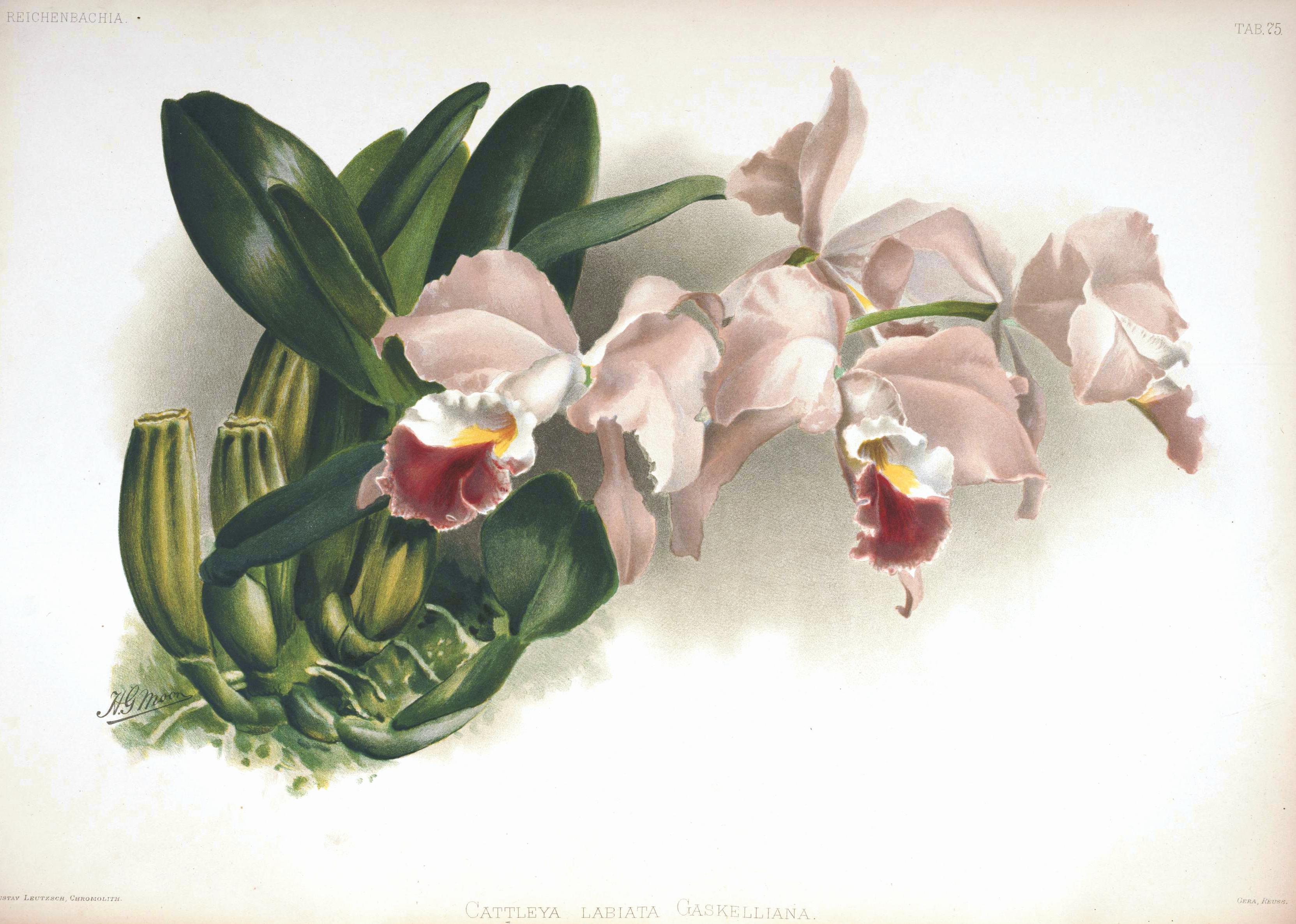
Cattleya gaskelliana was described by Heinrich Gustav Reichenbach in 1883, after it flourished for the first time in the English greenhouses of Frederick Sanders who, in turn, dedicated it to Holbrook Gaskell, a notable collector from the north of England.
It is endemic to the northeast of Venezuela, in the eastern branch of the Cordillera de la Costa, between 8° and 10° north latitude and 62° to 65° west longitude, specifically in the states of Anzoátegui, Monagas and Sucre.

Its habitat can be divided into two well-defined zones:
Zone 1: To the north of Monagas state and to the south of Sucre state. They grow on trees of medium to high height (15 to 40 meters) on the banks of rivers in an area of humid tropical forest, whose center of dispersion is the population of Caripe, in the state of Monagas, where rainfall is relatively abundant during all year. The altitude varies between 800 and 1300 meters above sea level. The plants in this area are quite robust and the pseudobulbs can reach up to 25 cm in length, with very leathery and wide leaves.
Zone 2: Northeast of Anzoátegui state, in a small area of tropical dry forest known as “New World”, where they develop as lithophytes on the rocky slopes of rivers, sometimes in full sunlight. There they thrive between 1,300 and 1,500 meters above sea level and form large colonies. Plants in this area are generally smaller and slimmer than their cariperas sisters. This region has been harshly punished by collectors for years and, today, it is very difficult to observe any plant in its natural habitat.
They are medium-sized plants, with strongly compressed pseudobulbs attenuated towards the base and formed by two or three internodes. A single very coriaceous leaf, oblong-elliptical, which forms about 30° inclination with respect to the bulb. Lone spat.
They bloom between the beginning of April and the middle of June. Each inflorescence bears between 2 and 6 flowers that reach between 14 and 20 cm in diameter, erect and well presented on the foliage, although they are somewhat weak in substance, so they hardly last two weeks. The type color of the species is lilac or purple-pink, generally pale. The lip is large, round and slightly curly, with a well-defined triangular purple spot in front that never mixes with the yellow of the throat. It has a sweet and delicate aroma.
To recognize one we must notice several characteristics in the plant and in the flowers that can help us: first of all, it always blooms from an immature bulb. This means that when the pseudobulb is just finishing forming, the buttons on the spathe are already noticeable. This characteristic differentiates it from other similar species such as Cattleya labiata, Cattleya jenmanii, and Cattleya warneri.
As for the flowers, on the labellum we have the purple spot at the front separated from the yellow of the throat, a characteristic that it shares with Cattleya trianaei, but unlike the latter, if we look at the labellum from the side, in Cattleya gaskelliana the frontal lobe is long and highly wavy, while in Cattleya trianaei it is short. The column, for its part, presents on each side of the clinandrium a pronounced triangular tooth that often protrudes in front of the anther.
No variety of color in Cattleya gaskelliana can be considered rare, new wild clones of variable quality appear every year.
Among the best known clones in Venezuela, we can mention:
- tipo: Elena, Carmen Caballero, Black Tiger
- concolor: Simon Rodriguez
- semialba: Calex, Maruja, Nuria, Red Flame
- alba: Schnee, White Heritage, Katy
- coerulea: Blue Dragon, Drago, Mimi, Daniel Andres
Notable varieties:
RHS awarded C. gaskelliana three FCCs and six AMs, and the horticultural press wrote about it often. It was easy to grow, very free flowering, and had large 7-inch flowers with a nice fragrance and lovely delicate texture. Most C. gaskelliana are light lavender in color with a slightly darker lip that often has a saddle-shaped purple blotch or splash in the center like shown in Chadwick’s book page 118. Very few really dark forms have been found.
- C. gaskelliana f. semialba – clones like the one pictured in the book page 119
- C. gaskelliana f. coerulea ‘Blue Dragon’ – remarkable coerulea clone, it contributed significantly to the development of blue cattleya hybrids, shown on book page 120
- C. gaskelliana f. alba ‘Magic White Key’ HCC/AOS – alba clones of C. gaskelliana were the most outstanding and had the greatest impact on the breeding of fine Cattleya hybrids
- C. gaskelliana f. alba ‘White Heritage’ AM/AOS
- C. gaskelliana ‘Formosa’ AM/RHS (1899)
- C. gaskelliana ‘Fairy Queen’ AM/RHS (1913)
Notable Primaries:
- C. Ariel ‘coerulae’ (C gaskelliana ‘coerulescens’ x Gur. bowringiana ‘lilacina’) – made by Sir Jeremiah Coleman in 1915.
Cattleya percivaliana (Rchb.f.) O’Brien
The Gardeners’ chronicle 20: 404 (1883)
This extraordinary species of Cattleya was discovered in 1881 by William Arnold, collector of the Sanders house, in the state of Trujillo in western Venezuela. In 1882, H. G. Riechembach hastened to describe it, by publication in the Gardener’s Chronicle, as a variety of Cattleya labiata from some dried flowers sent by Mr. Sanders. A year later, James O’Brien, through publication in the same magazine, gave it the rank of a species with the name it maintains today. Cattleya percivaliana is known as “The Flower of the Liberator” thanks to the legend that tells how the Liberator Simón Bolívar, during the Admirable Campaign as he passed through the Merida Andes, received some “parasitic lilies” from some peasants with the last name Chacón, whose flowers great beauty captivated him so much that he decided to take several plants with him to give as gifts on his way through other countries as a symbol of good will.
Cattleya percivaliana is endemic to Venezuela, from the western region of the country, in the mountains of the Andes. Originally reported in the states of Trujillo, Mérida and Táchira, its habitat today is reduced to a small area in the state of Trujillo. Between the parallels 9° and 10° north latitude and the meridians 70° and 71° west longitude.

It grows between 1400 and 2000 meters above sea level. Despite being the highest growing Venezuelan Cattleya, in cultivation they can adapt very well to warmer climates. It can be found as an epiphyte in humid forests, or as a lithophyte on steep cliffs near river courses in full sun exposure. In cultivation it does not tolerate direct sun.
It is a compact plant, its pseudobulbs are oblong to obovoid, slightly compressed laterally, attenuated towards the base, with two (rarely three) internodes, up to 20 cm long, always unifoliate. Its leaves are quite leathery, elliptical. The spathe is simple, green, does not dry out when the plant blooms. Plants that grow higher, on rocks and in full sun, tend to be smaller.
It blooms between September and November, in clusters of up to 5 flowers, small compared to its Venezuelan sisters. They reach about 15 cm in diameter, or up to 18 cm in plants called “grandifloras”. In general, its shape is good, with wide and flat petals. The lip is curly, sometimes with the notch of the frontal lobe very marked, which forces the disc to turn downwards.
To easily identify the species we can rely on the following aspects: first, the characteristic smell of burnt oil from its flowers. Then, the coloration of the lip is very particular: the reddish purple, when superimposed on the background yellow color, shows a dark brown hue that is very characteristic. Also, the purple color of the disk always occurs as clusters of dots, specks, or a solid patch, never in streaks or striations.
In addition to the type variety, it is common to find albs and semialba, but not coeruleas, which are still extremely rare to see in cultivation. The varieties of this species are the ones that have received the most popular names in Venezuela, which is quite rare in our country. For example, some albs are called “Oro Cochano” because of the golden yellow color of their labellum, others are called “Yellow Egg”. As for the semialba, some are known as “Centro Guayaba” and others as “Centro Chocolate”, due to the tone that the mixture of pink with yellow gives on the labellum. These semialba barely show a slight all over very pale lilac on the lip.
The only semialba with an intense purple lip bears the name of “Carache”, only she and her daughters share that characteristic. This clone is mistakenly known in other countries as “Farah Diba” because a plant was given to Queen Farah Diba, wife of the Shah of Iran Mohammad Reza Pahlavi, on a visit to Venezuela in 1975. In the United States it is also Known as “Jewel”. On the other hand, many plants known as semialba are actually albescens, because they show a very slight pinkish hue to their petals and sepals. This is the case of the famous “Sonia de Urbano” and most of her daughters.
Some 25 years ago, a very dark-colored plant appeared in cultivation that was called “Remolacha”, because its buds were as reddish and dark as the roots of beet (Beta vulgaris), but when the flower opened it presented a tessellated deep purple to white color pattern that was thought to be caused by a virus. Years later this plant was used in breeding programs and today we have a few beets of uniform color and extraordinary shape. In the same way, there are plants whose flowers have a lilac to moderate purple color, but their lip is completely intense reddish-purple that completely covers the yellow of the throat. This variety is known as “Centro Remolacha”.
Among the clones worth mentioning we have:
- type: Summit, Antonio Alvarado, Albert’s, Shibui, Luis Eduardo, La Unión, Héctor Alvarez
- alba: Oro Cochano, Carmelina, Negro Orozco, La Puerta
- semialba: Carache, Fiorella
- albescens: Sonia, Ana Beatriz
- caerulea: Undine
Notable varieties:
Cattleya percivaliana’s fragrance is usually described as “spicy” and most people like it. But, not everyone does, and it is the only Cattleya species which fragrance’s being doubted as pleasant and desirable.
- C. percivaliana f. alba ‘Lady Holford’ FCC/RHS (1913)
- C. percivaliana f. alba FCC/RHS (1884) – exhibited by R.P. Percival
- C. percivaliana f. semialba ‘Charlesworth’ FCC/RHS (1909) – the most famous semialba, which has a classic deep-reddish-purple lip that makes a striking constrast against the white sepals and petals
- C. percivaliana f. semialba ‘Jewel’ – commonly available semialbas today, it lacks the intense coloration of ‘Charlesworth’s’ lip, shown on Chadwick’s book page 116
- C. percivaliana ‘Summit’ AM-FCC/AOS – the most famous lavender clone which has a squarer shape than most other clones of C. percivaliana, they were grown for cut flowers by such growers as Lager and Hurrell, shown on Chadwick’s book page 115
- C. percivaliana ‘Grandiflora’ AM/RHS (1916) – there have been clones that had a 7-inch petal spread, but these have been very rare; ‘Grandiflora’ today is applied to any large-flowered clones, particularly those with good shape and a wider than normal lip
- C. percivaliana ‘Westonbirt’ AM/RHS (1910) – very impressive dark lavender form
Notable Primaries:
- C. Leda (C. percivaliana x C. dowiana) – Cattleya percivaliana has good shape and rich dark color. Add to this C. dowiana’s well-known effect of intensifying the color of other purple cattleya flowers, and C. Leda becomes not only a beautiful flower in its own right, but also a promising parent for dark purple hybrids.
Cattleya dowiana var. aurea (Linden) B.S.Williams & T.Moore
Notable varieties:
One of C. dowiana’s most unusual characteristics is the variability of the yellow color in the lip. One year the lip may have only a small amount of yellow or no yellow at all, and the next year that same plant may produce a lip that is almost all yellow. The amount of yellow can even vary from flower to flower on the same inflorescence as can be seen in the Cattleya dowiana aurea ‘Kathleen’ AM/AOS pictured in the book. This variability in yellow color even appears in the old lithographs of the 1800s. One of the most famous yellow-lip Cattleya dowiana is the clone ‘Statteriana’ which Linden featured in Plate 356 of Lindenia. In Lindenia it had an almost completely bright yellow lip. The Orchid Album also published a picture of ‘Statteriana’ in Plate 468 which shows a lip with only two enlarged yellow eyes with most of the lip being dark purple.
- C. dowiana var. aurea ‘Kathleen’ AM/AOS – shown on the book page 99, with somewhat unstable yellow color of the lip and can vary considerably from one year to the next; the photo is showing color instability even between flower on the same stem
- C. dowiana var. aurea ‘Little’ AM/RHS (1899) – exhibited by H. Little, slight purple feathering near column
- C. dowiana var. aurea – featured in L’illustration Horticole 3 (1883).
- C. dowiana var. aurea ‘Statteriana’ – featured in Lindenia 4 (1892), almost completely bright yellow lip
- C. dowiana var. aurea ‘Statteriana’ – featured in The Orchid Album (1893), showed only two enlarged yellow eyes with most of the lip being dark purple
Cattleya mendelii Dombrain
Floral Magazine (London) 1: t. 32 (1872)
Notable varieties:
RHS has given 16 First Class Certificates and more than 30 Awards of Merit to C. mendelii and most flowers exhibited had this beautiful contrast between the lip and the sepals and petals. C. mendelii has more semialba clones than any other of the Cattleya species, and very few true albas have been found. The two best-known albas were both imported by Low. Relatively few dark-petaled clones of C. mendelii have been found, and these have seldom been as beautiful as those with pastel sepals and petals and a contrasting darker lip. Cattleya mendelii also has flowers of relatively thin substance, which adds to their delicate beauty.
- C. mendelii f. alba ‘Bluntii’ FCC/RHS (1885) – was named for Low’s collector who found the plant
- C. mendelii f. alba ‘Stuart Low’ FCC/RHS (1910) – was an 8-inch giant with wide petals that is usually considered the finest alba clone of the species, surprisingly, ‘Stuart Low’ was still available commercially as late as 1950
- C. mendelii f. semialba ‘Thule’ AM/RHS (1912) – it has a pale pinkish tint to the lip that gives it an enchanting appearance
- C. mendelii f. semialba ‘Duke of Malborough’ FCC/RHS (1886) – featured in Reichenbachia 1 pg. 35 (1893)
- C. mendelii f. semialba ‘Measuresiana’ – quoting R.A. Rolfe editor of The Orchid Review “Owing to the exceeding great beauty of this variety, the Reichenbachia is adorned by one of the finest paintings that ever left the pencil of a painter in any age.”
- C. mendelii f. semialba ‘Carlos Arango’ – is one of the best modern day varieties of the species, shown on book page 110
- C. mendelii f. albens ‘Princess of Wales’ FCC/RHS (1900) – quasialba form with very nice compostition
- C. mendelii f. albescens AM/RHS (1899) – quasialba form with wide petals
- C. mendelii ‘Amelia’ AM/RHS (1898) – semialba form with blush on the lip
- C. mendelii ‘Beatrice Ashworth’ AM/RHS (1898) – alba form
- C. mendelii ‘Burford’ AM/RHS (1899) – light lavender form with impressive contrasting crimson lip
- C. mendelii ‘Cicero’ AM/RHS (1905) – light lavender form, gigantic flower with droopy petals and nice dark extra frilly lip
- C. mendelii ‘Frances Wellesley’ AM/RHS (1907) – semialba form with purple lip tip
- C. mendelii ‘Gigantea’ AM/RHS (1901) – light lavender form, gigantic flower with droopy petals
- C. mendelii ‘His Majesty the King’ FCC/RHS (1908) – pale lavender form with very nice composition and little bit of purple at the lip tip
- C. mendelii ‘King George V’ AM/RHS (1910) – dark lavender form with unusual white lateral sepals
- C. mendelii ‘Madonna’ AM/RHS (1897) – semialba form with dark purple blotch on the lip
- C. mendelii ‘Mercury’ AM/RHS (1906) – light lavender form, gigantic flower with droopy petals and nice dark lip
- C. mendelii ‘Mrs E. V. Low’ AM/RHS (1898) – semialba form with upright petals and dark purple blotch on the lip
- C. mendelii ‘Mrs Frederick Knollys’ AM/RHS (1906) – concolor form and exposed column
- C. mendelii ‘Mrs Robert Tunstill’ AM/RHS (1901) – semialba form with very pleasant composition and upright dorsal sepal
- C. mendelii ‘Mrs Smee’ AM/RHS (1915) – light lavender form with balanced overall round composition and impressive dark lip
- C. mendelii ‘Oakes Ames’ FCC/RHS (1898) – flamea form with flaring on petals with light lavender perianth, and gorgeous dark lip
- C. mendelii ‘Pearl McBean’ AM/RHS (1910) – flamea form with flaring on petals with balanced composition and impressive dark lip
- C. mendelii ‘Perfection’ AM/RHS (1899) – gigantic flower with falcate petals
- C. mendelii ‘Princess Victoria’ FCC/RHS (1910) – light lavender form with pleasant lip colouring
- C. mendelii ‘Queen Alexandra’ AM/RHS (1901) – flamea form with flaring on petals with balanced composition
- C. mendelii ‘Queen Mary’ FCC/RHS (1912) – semialba form with very pale pastel lip, nice upright petals and pleasant shape
- C. mendelii ‘Queen Maud’ AM/RHS (1910) – semialba form with fuschia lip
- C. mendelii ‘Wisetonensis’ AM/RHS (1902) – light lavender form, gigantic flower with droopy petals and nice dark lip
Notable primaries:
- Bc. Digbyano-mendelii (C. mendelii x B. digbyana)
- C. Atlantic (C. mendelii x C. trianaei)
- C. Armainvillierensis (C. mendelii x C. warscewiczii)
- C. Suavior ‘Aquinii’ (C. mendelii x C. intermedia ‘aquinii’) the best red-colored primary hybrid
- Sc. Thwaitesii (C. mendelii x Soph. coccinea), which had better shape, size, and a clearer red color than Sc. Doris (C. dowiana x Soph. coccinea)
Cattleya eldorado Linden
Flore des serres et des jardins de l’Europe 18: 13 (1869-1870)
L’Illustration horticole 17: 36 (1870)
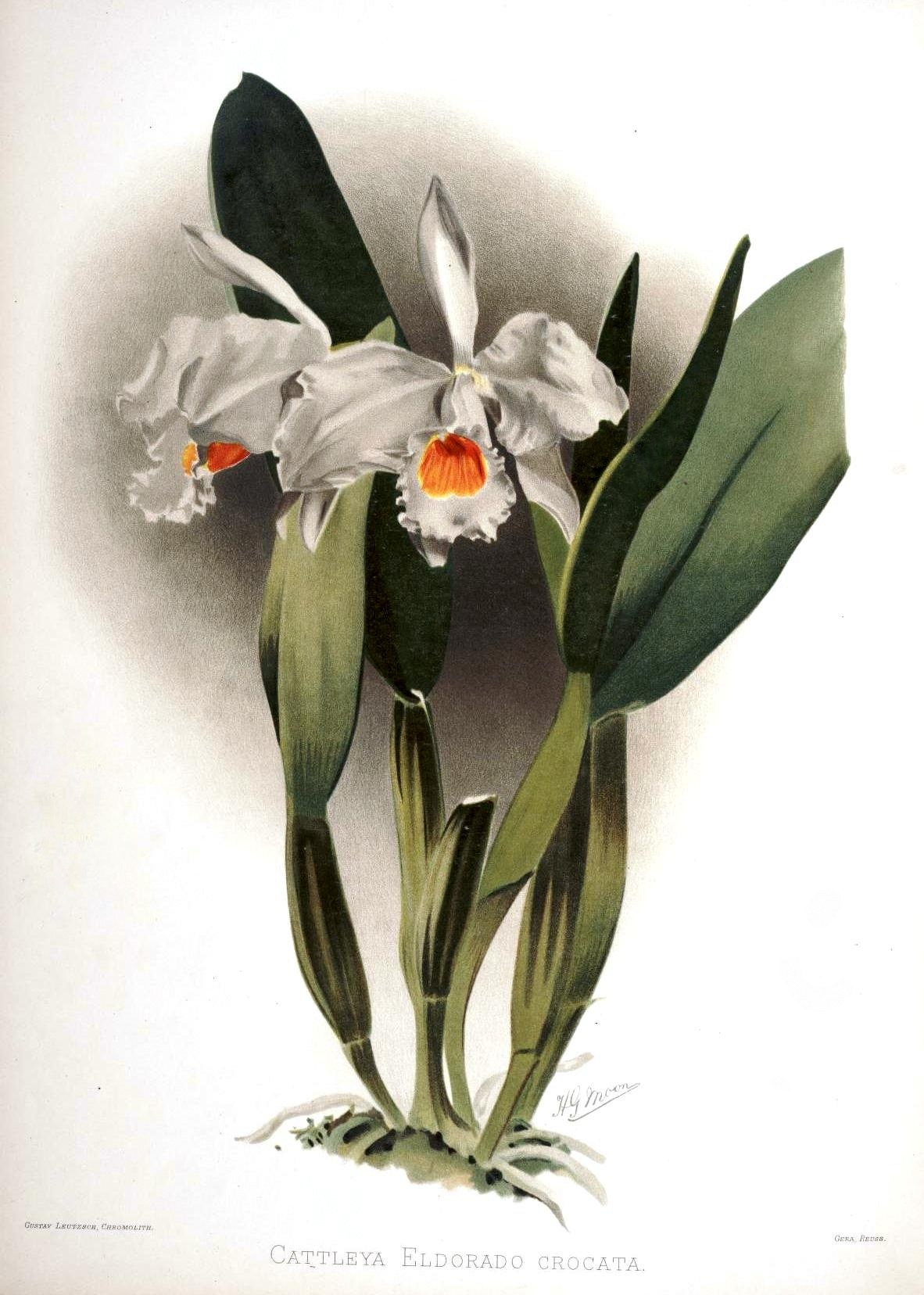
Notable varieties:
Although alba forms of C. eldorado are more common than usual, the semialba form is quite rare. Semialba C. eldorado are attractive because the white petals seem to accentuate the white fringe around the orange disc in the lip. Albescens and concolor forms of C. eldorado are also much more common than in other Cattleya species. Cattleya eldorado’s extensive range of coloring includes coeruleas, medium lavenders and even dark lavender flowers, some of which are quite gorgeous.
- C. eldorado f. alba ‘Virginalis’ – alba forms are not at all rare in C. eldorado and the alba forms also have some of the largest and best-shaped flowers in the species — another unusual characteristic for this species, this one was described by A. Ducos in L’Illustration Horticole in 1876 as a new species and given the name Cattleya virginalis. This was, of course, later corrected to C. eldorado ‘Virginalis’ but it reflected the unusually fine appearance of the flowers over the ordinary C. eldorado
- C. eldorado f. alba ‘Crocata’ – was pictured in Sander’s magnificent book, Reichenbachia 2 (1890), as an example of an unusually large and well-shaped flower born on a larger than normal plant
- C. eldorado f. semialba ‘Enfieldiensis’ AM/RHS (1900) – exhibited by Mr. H. Low,
- C. eldorado ‘Splendens’ FCC/RHS (1868) – exhibited by Linden
- C. eldorado ‘Glebelands’ AM/RHS (1899) – exhibited by J. Gurney Fowler
- C. eldorado f. albescens – quite common
- C. eldorado f. concolor – quite common
Notable primaries:
- C. Iridescens (C. eldorado x C. bicolor)
- C. Lady Ingram (C. eldorado x C. dowiana)
- C. x brymeriana (C. eldorado x C. violacea)
